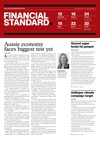Search Results | Showing 281 - 290 of 313 results for "waste" |
| | | ... they believe they have a responsibility to operate sustainably, only 20-30% of those respondents measure and report energy, waste and water usage regularly. In their annual Fund Sustainability Review 2012, SuperRatings found that the introduction of ... |
| | | | ... emissions. Biochar is a stable, carbon-rich type of charcoal that is made by "heating organic materials, such as wood or crop waste, in a low oxygen environment," according to DAFF. Biochar can be added to soil to sequester carbon and can potentially ... |
| | | | ... building's NABERS rating from 3 to 4.5, revegetating a 40 metre section along the Brisbane River and diverting over 9 tonnes of waste per year from landfill through a use of shredding, comingled recycling and composting of organic material. The firm ... |
| | | | ... "inform the design and operation of water systems present in the development" from 2012. GPT reported that for 2011, recycled waste was 19,327 tonnes and landfill waste was 22,339 tonnes. For 2012, the company has set targets to achieve operational recycling ... |
| | | | ... neutral after the company assessed energy usage and developed a sustainability strategy. The strategy focuses on reducing waste to landfill, increasing recycling, increasing the use of recycled products, reducing use of consumables and paper and introducing ... |
| | | | ... environmental upgrade agreements (EUAs) and the opportunities they present for commercial building owners and suppliers of waste, water and energy efficiency solutions, said Scott Bocskay, chief executive of the Sustainable Melbourne Fund. "It highlighted ... |
| | | | ... 2011 fiscal year, but environmental performance indicators - greenhouse gas emissions, electricity, paper consumption and waste generation - grew disproportionately to revenue, the firm disclosed. "While some increased consumption can be attributed to ... |
| | | | ... new guidance for the events sector to increase the relevance of reporting on issues including greenhouse gas emissions, waste, attendee travel, event legacy, and initiatives taken at an event to promote sustainability and transparency. The Event Organizers ... |
| | | | ... integrated retail property group, has reported lower direct and indirect GHG emissions in 2010, attributed to decreases in waste sent to landfill and to offsets from purchased electricity emissions balancing increases in direct emission increases arising ... |
| | | | ... anti-corruption policy, lowered lost time injury frequency rates (LTIFR) by 30% and lowered energy consumption, greenhouse gas and waste intensity per unit of vaccine and plasma production, against a backdrop of net profit after tax of AU$941m. In their ... |
|

















